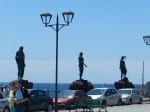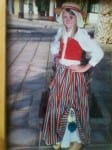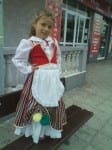This week it has become clear to me that I want to represent my piece from the POV of Catalina Lercaro; a young lady who’s ghost is supposed to haunt her old home, The Lercaro Mansion (Now a History Museum).
I have always been very attached to this young woman’s story and now have an opportunity to explore it and use it in a piece; this story is also a large part of history of the Canary Islands. I believe that showing the history and culture through Catalina’s eyes (the eyes of a ghost) gives me a good opportunity to not only tell her story but to talk of what she has witnessed too, it gives me an opportunity to refer to the past and present through her eyes; eyes that would have witnessed history.
This week we did an “imagination exercise” to create a character, and though we was told a story specifically to help us develop a character different from any preconceptions we may have, I instantly ended thinking of Catalina and how I thought she might be. The descriptions in the story led me to Tenerife and to her and to something she might have done. However, when we was asked later on to write details about the character in“Passport”, even though I found it very easy to imagine how she might have been as a person, I found it very difficult to write specifics such as Star sign or Age or Distinguishing Mark due to the fact that she was a real person and I want to stray from the truth about her as little as possible, I want to be honest and truthful about this young lady as best I can.
From this, my piece now has taken the turn to start with Catalina telling her own story; who she was, who her family was, what happened to her that fateful night (the question being raised; did she really commit suicide? or was she murdered and it was covered up?). She would then go on to tell the audience how over the years she has watched many people come and go from her home, mostly visitors that come to see her family’s stuff and be told her story as her home has now been turned into a museum (angry about this? not bothered?). From the visitors she could talk about how she has seen different customs from different countries over the years (England, France, Germany…) and how this made her venture outside to see how the world had changed; she saw people her own age getting drunk like old men used to, she saw dancing and then throwing up, she saw people be lazy all day and not do anything. “We have a culture you know? The Canary Islands” go in to tell the audience how there is a beautiful history and culture and how she will tell them some of it; tell them a little about the Menceyes (The Guanche Kings) and how the island of Tenerife was split into sections; “Kingdoms”.Tell them about how she witnessed the Volcano cover Garachico in lava, how all the people screamed and ran in horror and hid in the church. Tell them of the beautiful Lady of Candelaria and how she appeared in a cave near the beach. Tell them of our festivals such as SanJuan Night and Canarian Day. From Canarian day she will show them some of the floklore songs and some of the traditional dances, offer them some traditional Canarian food (Papas Arrugadas, Empanadas de batata, Pulpo…), tell them about the games that are played and eventually how every year the Canarian culture is celebrated on the 30th of May and how others coming from the outside are welcome to celebrate with us. Finish the performance by telling the audience that there are many myths and legends too (tell them about the Dragon tree, the girl of the pears, Gara and Jonay, how the Canary Islands are said to be the peaks of Atlantis….) and finish by saying “There are many stories and legends in the Canaries, I have told you but a few, and now I must go back to being one myself. Don’t be afraid to explore, the islands are full of z fascinating history and you never know what secrets might be uncovered next”.









